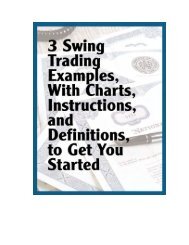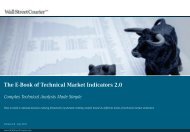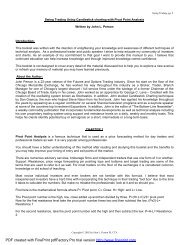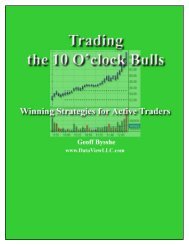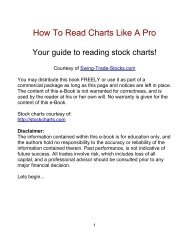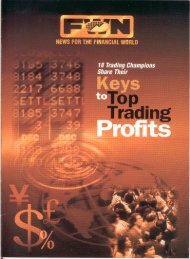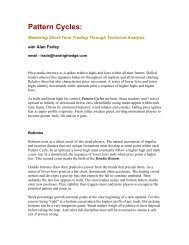To all those who did not dedicate - The Swing Trading Guide
To all those who did not dedicate - The Swing Trading Guide
To all those who did not dedicate - The Swing Trading Guide
You also want an ePaper? Increase the reach of your titles
YUMPU automatically turns print PDFs into web optimized ePapers that Google loves.
A Practical <strong>Guide</strong> to <strong>Swing</strong> <strong>Trading</strong> by Larry <strong>Swing</strong><br />
Figure 5: Equivolume<br />
<strong>The</strong> shape of each Equivolume box provides a picture of the supply and demand for<br />
the security during a specific trading period. Short and wide boxes (heavy volume<br />
accompanied with sm<strong>all</strong> changes in price) tend to occur at turning points, while t<strong>all</strong><br />
and narrow boxes (light volume accompanied with large changes in price) are more<br />
likely to occur in established trends.<br />
Especi<strong>all</strong>y important are boxes that penetrate support or resistance levels, since<br />
volume confirms penetrations<br />
A "power box" is one in which both height and width increase substanti<strong>all</strong>y. Power<br />
boxes provide excellent confirmation of a breakout. A narrow box, due to light<br />
volume, casts doubt on the validity of a breakout in question.<br />
We always look at volume in relation with price movement:<br />
�<br />
Volume<br />
Trend Reversal<br />
� Above-Average Volume with LITTLE price movement<br />
� Above-Average Volume after a huge advance or decline<br />
Trend Continuation<br />
� Above-Average Volume with STRONG price movement<br />
� Above-Average Volume with breakout<br />
� Below-Average Volume with NO price movement<br />
Visit: http://www.mrswing.com/ or email: larry@mrswing.com



